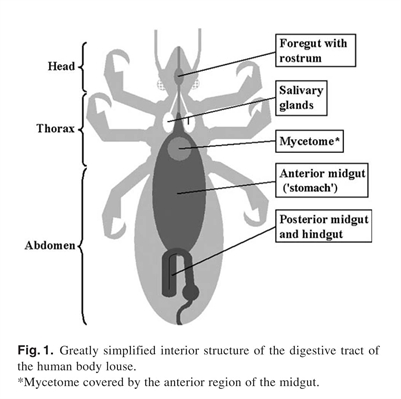
Nutrition
Pediculus humanus is one of many
insects that suck blood for food. Out of about 4,000 species of lice, only 560
species feed on vertebrates by sucking their blood
(Resh
and Carde 2003).
From the beginning of their existence, blood is a necessity for survival. After
an egg hatches into a nymph, it must feed within a few hours or will die from
starvation and dehydration.
To start the process, the human lice use its
specialized mouth parts for penetrating into the human host’s skin and sucking
up the blood. This insect can take in the amount of blood that is one third of
their own body weight about every three to six hours. Because of the frequent
feeding, human lice will spend their entire life on the host.

The blood will be stored in the anterior region of the midgut, or the stomach. Even though blood is nutritious, it still lacks essential components, such as B-vitamins that it needs to survive. The lice use symbiotic bacteria which are concentrated in the mycetome to obtain these other essential components blood lacks. The mycetome is a disc-shaped organ which is located on the ventral side of the midgut (Waniek 2009).
Human lice are part of Phylum Arthropoda which have and open circulatory system consisting of dorsal heart, arteries and sinuses that make up the hemocoel. The tubular heart of Class Insecta located in the pericardial cavity moves hemolymph, and the hemolymph is responsible for distribution of substances such as nutrients throughout the body (Hickman et al. 2009).